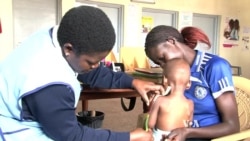In a health clinic in Mathare, one of Nairobi’s roughest slums, families fill the waiting room. Here, the charity German Doctors runs a feeding program for malnourished children.
Caroline Munyi, a pediatric nurse, says some of the children are in very bad shape. As of last Friday, "we had 35 patients we have admitted since January, and most of them with kwashiorkor." Signs of the protein deficiency can include a protruding belly, emaciated limbs, discolored hair and skin, fatigue and more.
Munyi recalls that, "at one time we had more than 250 patients we were feeding every day. It was overwhelming."
But a line of street vendors outside the clinic represents a different face of Kenya’s malnutrition problem.
Mathare street food consists of different types of dough, flattened into chapattis, deep-fried as pastries or packaged into oily samosas. Local residents eat a lot of this, Munyi says.
"There are people actually who rely on street food wholly," she says. "… They can’t afford fuel in the house so they want the ready-cooked food, which they consider much cheaper."
Obesity rates rising
As in much of the rest of Africa, Kenya’s obesity rates have been steadily climbing. About 25 percent of Kenyan women are now obese, a rate that rises to 40 percent in urban areas.
Among the growing middle class, this obesity epidemic looks a lot like it does in the West: Working women have less time to cook healthy meals, while people get less exercise and eat more processed foods.
But in the slums, obesity can be a sign not of overeating but of malnutrition, says Elizabeth Kimani, who works with Nairobi’s African Population and Health Research Center. The poorest rely heavily on cheap foods that are high in fat but low in nutrients, which can cause both obesity and stunting.
The center found that 43 percent of women who are overweight have children whose growth is stunted, Kimani says. “So we are talking of coexistence in the same household, not even just in the community.”
Poor vulnerable to ill effects
In fact, she says, the poor may have an even higher chance of becoming obese than those who grow up well fed.
"Evidence has shown that if you are stunted when you are very young you are likely to be obese later in life," Kimani explains. "So that could also be the reason why we are having very many stunted children but we have quite a number of obese or overweight adults."
Munyi says the number of obesity-related cases in the local hospital has nearly doubled since last year.
Related diseases increase
Kimani adds that the growing ranks of overweight Africans is starting to take its toll, as more and more develop diabetes, hypertension and other conditions.
"They are burdening the health care system," she says. "In the past, people used to die of infectious diseases, but now we are realizing that a lot of people are dying from these metabolic diseases and it’s actually costing the country so much. We are in a transition where this is happening all over Africa."
Kimani says more effort is needed to educate the public about proper nutrition and exercise. The ingredients of processed foods should be controlled as well, she says.
But with nutritionists in Africa now fighting on two fronts, keeping people healthy is becoming more complex every day.










